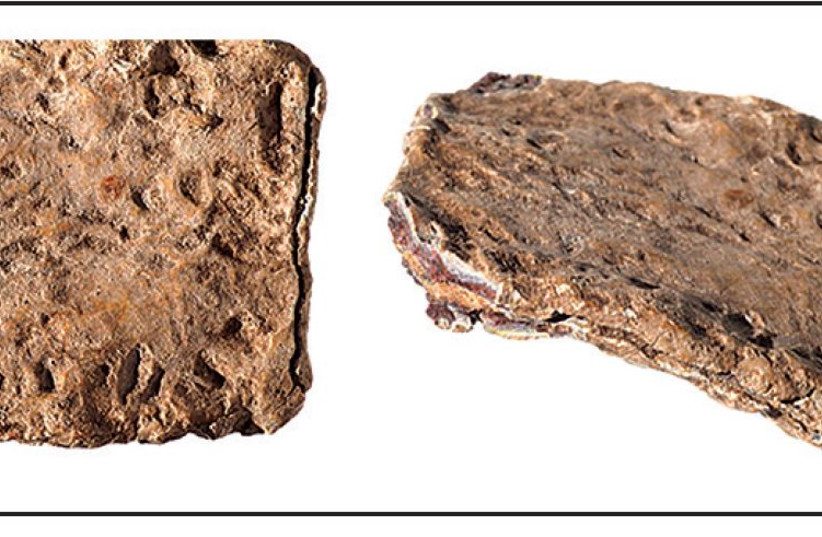Last year, with much public fanfare, a team of American, European, and Israeli archaeologists and Jewish history and biblical studies academics claimed in a journal that they had discovered a tiny lead object with an early Hebrew curse inscription, supposedly the earliest Hebrew inscription ever found, from the early Iron Age site of Mt. Ebal.
In their well-publicized press releases and journal publication, they claimed that this object was inscribed both on its inside and outside with curses, repeatedly using the Hebrew term arur (cursed). Supposedly, this fits in well with the identification of this site as the Altar of Joshua, mentioned in the biblical text, at which a similar curse formula was used.
It was written by Prof. Gershon Galil, a Jewish history and biblical studies researcher at the University of Haifa; Scott Stripling of the Archaeological Studies Institute in Katy, Texas; Ivana Kumpova, Daniel Vavrik and Jaroslav Valach of the Institute of Theoretical and Applied Mechanics the Czech Academy of Sciences; and Pieter Gert van der Veen at the Department of Old Testament and Biblical Archaeology at the Johannes Gutenberg University in Germany.
But now, Prof. Aren Maeir – head of the Institute of Archaeology at Bar-Ilan University (BIU) in Ramat Gan, and Christopher Rollston (George Washington University), are critically considering the context and dating of the object, along with questions on the character of the site. Most importantly, the very reading that Stripling et al. suggest for the inner inscription (the outer one was not published) is seriously questioned, and it is shown to be problematic at best, and perhaps even non-existent.
The original authors who made the claims in the journal Heritage Science said they were able to show the inner inscription of this object using X-ray tomography, as the object could not be opened.


Claims are "quite dramatic and require close inspection"
“These claims are quite dramatic and require close inspection,” wrote the doubters covering some 21 pages in the Israel Exploration Journal under the title “The so-called Mount Ebal curse tablet: A critical response.”
“Indeed, a series of three articles question the suggested interpretation of this find. In the second paper, Amihai Mazar of the Hebrew University of Jerusalem (HU) suggests that the lead object is in fact a lead fishing weight that is commonly found during the Late Bronze and Iron Ages in the Aegean and eastern Mediterranean regions – “hardly the dramatic interpretation suggested by Stripling and colleagues. “
In the third paper, HU’s Naama Yahalom-Mack publishes the isotopic analysis of the lead of the objects howing that the isotopic composition is consistent with the lead mines from Lavrion, Greece. That said, as opposed to the original claims, this does not prove that this object dates to the Late Bronze Age, as lead from Lavrion is known from other periods as well.
In December 2019, an expedition on Mount Ebal to wet sift the discarded material from excavations led by Adam Zertal – a prominent but controversial University of Haifa archaeologist who died at the age of 79 in 2015 – from decades earlier, yielded a small, folded lead tablet.
The east dump pile from which the object emerged contained the discarded matrix from two structures that he interpreted as altars dated to the Late Bronze Age II and Iron Age I. The earlier and smaller round altar lay underneath the geometric center of the later and larger rectangular altar.
The biblical tradition (Joshua 8:30) notes that Joshua, the leader of the Israelites who was appointed to take over from Moses, built an altar on Mount Ebal as part of a ceremony to renew the covenant soon after they returned from Egypt to Canaan. In Deuteronomy (11:26,29), Moses tells the nation that when they finally enter the Land of Israel, they should recite blessings at the flowering Mount Gerizim and curses at the opposite mountain, the barren Mount Ebal.
Tomographic images "fail to demonstrate any discernible letters"
“We contend that their tomographic images fail to demonstrate any discernible letters and have concerns about the authors’ dating of the archaeological material from this site. Here, we critically examine their claims, suggesting that most conclusions lack an empirical basis. Ultimately, this artifact is most reasonably understood as an uninscribed lead fishing-net weight,” wrote Maeir.
“Since any putative writing on the outside would not need to be tomographically reconstructed, but instead, could be read with the naked eye or the naked eye assisted by a stereo-microscope, we suggest it would have been methodologically useful for the authors to have first ascertained the morphology and ductus of the putative letters on the outside of this inscription, and then to have used that knowledge of the script’s morphology and ductus to assist in the more complex process of attempting to read any putative letters on the inside of the lead” As for the alleged writing on the interior, the authors stated, “epigraphic analysis of the tomographic data revealed a formulaic curse written in a proto-alphabetic script likely dating to Late Bronze Age II.”
It would have been more proper if all these assertions had been backed up by a decipherable inscription. After all, they wrote, “This artifact does hail from an archaeological site likely related to the early Israelite settlement. However, dramatic claims require dramatic and demonstrable evidence, and we contend these claims, as presented in their article, falter on credible, verifiable evidence.”
In addition, they wrote in the new study, despite the alleged context of the find from a specific dump supposedly derived from a specific part of the site, these deposits were collected and sifted some 30 years after the original excavations. These dumps could have been disturbed, as there was substantial disturbance and destruction at the site during this time. While it is probable that this artifact derives from this site, it is possible that it was brought there after the original excavations,” they concluded.
